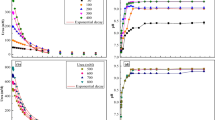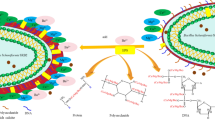Abstract
Microbial/Enzyme-induced carbonate precipitation uses bacteria/urease to drive the biogeochemical reactions to generate CaCO3 precipitation. The goal of this study was to assess the impact of initial concentrations of urease and bacteria on precipitation kinetics and crystal morphology (crystal shape and chemical composition) of calcium carbonate precipitation. Experimental results showed that the CaCO3 precipitation kinetics were well-fitted by a modified exponential logistic model with a confidence value of 95%, and higher concentrations of bacteria and urease could increase the precipitation rate of CaCO3. The results of XRD, FTIR and SEM indicated that vaterite phase was the dominant form of CaCO3 crystals in bacteria-induced system, and calcite phase was the primary form of the CaCO3 crystals in urease-induced system. The results also showed that the effect of initial concentrations of bacteria and urease on the morphology of CaCO3 crystals was insignificant.








Similar content being viewed by others

References
Al Imran M, Shinmura M, Nakashima K, Kawasaki S (2018) Effects of various factors on carbonate particle growth using ureolytic bacteria. Mater Trans 59(9):1520–1527
Al Qabany A, Soga K, Santamarina C (2011) Factors affecting efficiency of microbially induced calcite precipitation. J Geotech Geoenviron 138(8):992–1001
Almajed A, Khodadadi H Kavazanjian Jr E (2018) Sisal fiber reinforcement of EICP-treated soil. In: IFCEE, pp 29–36
Almajed A, Tirkolaei HK, Kavazanjian E, Hamdan N (2019) Enzyme induced biocementated sand with high strength at low carbonate content. Sci Rep 9(1):1135
Bu C, Wen K, Liu S, Ogbonnaya U, Li L (2018) Development of bio-cemented constructional materials through microbial induced calcite precipitation. Mater Struct 51(1):30
Bu C, Wen K, Liu S, Ogbannaya U, Li L, Amini F (2018) Development of a rigid full contact mold for preparing bio-beams through microbial induced calcite precipitation. Geotech Test Method ASTM 42(3):656–669. https://doi.org/10.1520/GTJ20170148
Cheng L, Shahin MA, Mujah D (2016) Influence of key environmental conditions on microbially induced cementation for soil stabilization. J Geotech Geoenviron 43(1):04016083
Chu J, Ivanov V, Naeimi M, Stabnikov V, Liu HL (2014) Optimization of calcium-based bioclogging and biocementation of sand. Acta Geotech 9(2):277–285
DeJong JT, Fritzges MB, Nüsslein K (2006) Microbially induced cementation to control sand response to undrained shear. J Geotech Geoenviron 132(11):1381–1392
DeJong JT, Mortensen BM, Martinez BC, Nelson DC (2010) Bio-mediated soil improvement. Ecol Eng 36(2):197–210
Dyer M, Viganotti M (2016) Oligotrophic and eutrophic MICP treatment for silica and carbonate sands. Bioinspir Biomim Nan 6(3):168–183
Ghosh T, Bhaduri S, Montemagno C, Kumar A (2019) Sporosarcina pasteurii can form nanoscale calcium carbonate crystals on cell surface. PLoS ONE 14(1):e0210339
Hamdan N, Kavazanjian Jr E, O’Donnell S (2013) Carbonate cementation via plant derived urease. In: Proceedings of the 18th international conference on soil mechanics and geotechnical engineering, Paris
Kavazanjian E Jr, Almajed A, Hamdan N (2017) Bio-inspired soil improvement using EICP soil columns and soil nails. Grouting 2017:13–22
Li W, Liu L, Chen W, Yu L, Li W, Yu H (2010) Calcium carbonate precipitation and crystal morphology induced by microbial carbonic anhydrase and other biological factors. Process Biochem 45(6):1017–1021
Li W, Chen WS, Zhou PP, Zhu SL, Yu LJ (2013) Influence of initial calcium ion concentration on the precipitation and crystal morphology of calcium carbonate induced by bacterial carbonic anhydrase. Chem Eng J 218:65–72
Li M, Li L, Ogbonnaya U, Wen K, Tian A, Amini F (2015) Influence of fiber addition on mechanical properties of MICP-treated sand. J Mater Civ Eng 28(4):04015166
Li M, Wen K, Li Y, Zhu L (2018) Impact of oxygen availability on microbially induced calcite precipitation (MICP) treatment. Geomicrobiol J 35(1):15–22
Lin H, Suleiman MT, Brown DG, Kavazanjian E Jr (2015) Mechanical behavior of sands treated by microbially induced carbonate precipitation. J Geotech Geoenviron 142(2):04015066
Loste E, Wilson RM, Seshadri R, Meldrum FC (2003) The role of magnesium in stabilising amorphous calcium carbonate and controlling calcite morphologies. J Cryst Growth 254(1–2):206–218
Manoli F, Dalas E (2000) Spontaneous precipitation of calcium carbonate in the presence of chondroitin sulfate. J Cryst Growth 217(4):416–421
Martinez BC, DeJong JT, Ginn TR, Montoya BM, Barkouki TH, Hunt C et al (2013) Experimental optimization of microbial-induced carbonate precipitation for soil improvement. J Geotech Geoenviron 139(4):587–598
Mortensen BM, Haber MJ, DeJong JT, Caslake LF, Nelson DC (2011) Effects of environmental factors on microbial induced calcium carbonate precipitation. J Appl Microbiol 111(2):338–349
Sondi I, Salopek-Sondi B (2005) Influence of the primary structure of enzymes on the formation of CaCO3 polymorphs: a comparison of plant (Canavalia ensiformis) and bacterial (Bacillus pasteurii) ureases. Langmuir 21(19):8876–8882
Stocks-Fischer S, Galinat JK, Bang SS (1999) Microbiological precipitation of CaCO3. Soil Biol Biochem 31(11):1563–1571
Tong H, Ma W, Wang L, Wan P, Hu J, Cao L (2004) Control over the crystal phase, shape, size and aggregation of calcium carbonate via a l-aspartic acid inducing process. Biomaterials 25(17):3923–3929
Van Paassen LA (2009) Biogrout, ground improvement by microbial induced carbonate precipitation, Doctoral dissertation, TU Delft, Delft University of Technology
Wang Y, Soga K, Dejong JT, Kabla AJ (2019) A microfluidic chip and its use in characterising the particle-scale behaviour of microbial-induced calcium carbonate precipitation (MICP). Géotechnique 69(12):1–9
Wen K, Bu C, Liu S, Li Y, Li L (2018) Experimental investigation of flexure resistance performance of bio-beams reinforced with discrete randomly distributed fiber and bamboo. Constr Build Mater 176:241–249
Wen K, Li Y, Liu S, Bu C, Li L (2019) Development of an improved immersing method to enhance microbial induced calcite precipitation treated sandy soil through multiple treatments in low cementation media concentration. Geotech Geol Eng 37(2):1015–1027
Wen K, Li Y, Liu S, Bu C, Li L (2019) Evaluation of MICP treatment through electric conductivity and pH test in urea hydrolyzed process. Environ Geotech. https://doi.org/10.1680/jenge.17.00108
Xu X, Han JT, Cho K (2004) Formation of amorphous calcium carbonate thin films and their role in biomineralization. Chem Mater 16(9):1740–1746
Yasuhara H, Hayashi K, Okamura M (2011) Evolution in mechanical and hydraulic properties of calcite-cemented sand mediated by biocatalyst. In: Geo-frontiers 2011: advances in geotechnical engineering, pp 3984–3992
Yasuhara H, Neupane D, Hayashi K, Okamura M (2012) Experiments and predictions of physical properties of sand cemented by enzymatically-induced carbonate precipitation. Soils Found 52(3):539–549
Zhang Y, Guo HX, Cheng XH (2015) Role of calcium sources in the strength and microstructure of microbial mortar. Constr Build Mater 77:160–167
Zhao Q, Li L, Li C, Li M, Amini F, Zhang H (2014) Factors affecting improvement of engineering properties of MICP-treated soil catalyzed by bacteria and urease. J Mater Civ Eng 26(12):04014094
Acknowledgements
This paper is based upon work supported by the Nation Science Foundation Grant Nos. 1531382, 1924241 and U.S. Department of Transportation Grant No. (DTRT13-G-UTC50FHWA) through Maritime Transportation Research and Education Center.
Author information
Authors and Affiliations
Corresponding author
Additional information
Publisher's Note
Springer Nature remains neutral with regard to jurisdictional claims in published maps and institutional affiliations.
Rights and permissions
About this article
Cite this article
Wen, K., Li, Y., Amini, F. et al. Impact of bacteria and urease concentration on precipitation kinetics and crystal morphology of calcium carbonate. Acta Geotech. 15, 17–27 (2020). https://doi.org/10.1007/s11440-019-00899-3
Received:
Accepted:
Published:
Issue Date:
DOI: https://doi.org/10.1007/s11440-019-00899-3



